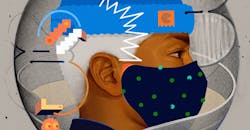What Technologies are You Using to Settle Into the New Normal?
Even for the most progressive manufacturers, navigating the new normal is a challenging endeavor. Manufacturers understandably want to return to work – achieving needed productivity levels – yet vital concerns about worker health and safety run rampant. Fortunately, a wealth of interesting and often innovative strategies and technologies are surfacing to help ease the way. This includes technologies designed to enable production during an era of social distancing as well as monitor health and safety of employees.
One commonality in many of these new offerings: a reliance on digitalization. By embracing digital technologies, manufacturers have the opportunity to support sophisticated health and safety elements that go beyond simple people watching, such as:
- Thermal cameras detecting elevated temperatures;
- Audio sensors detecting coughs; and
- Video streams monitoring proper hand washing procedures, social distancing regulations and mask/facial covering requirements.
Through real-time artificial intelligence capabilities, manufacturers can collect and process sensor data, identify issues within seconds and generate automated alerts of any compliance violations in real-time.
IndustryWeek recently had the opportunity to connect with Foghorn CEO David King to how the strategic use of today’s technology can efficiently track and flag health and safety processes while mitigating the impact of future workplace outbreaks.
IW: How can manufacturers leverage automated, real-time analytics, paired with artificial intelligence, to efficiently track and flag health and safety processes?
King: In light of COVID-19 and beyond, industrial organizations must ensure that staff and visitors are following appropriate health and safety guidelines, like the use of masks, gloves, etc. To date, monitoring has not been available or is conducted by supervisors or staff observing adherence to practices and through posted reminders. Leveraging real-time streaming video analytics and artificial intelligence, enabled by edge processing capabilities for video, audio, and thermal cameras, organizations can automate health and safety auditing and generate alerts when unsafe conditions are detected.
Organizations can use existing video cameras within their business to deploy edge-based advanced analytics software to track and flag health and safety processes. Alternatively, organizations can install additional thermal cameras, at critical, high-traffic meeting points, like facility entrances to detect elevated body temperatures.
For example, many factories, distribution centers, and food processing plants track if employees are wearing facial coverings, adhering to social distancing guidelines, and washing their hands properly. Using edge AI technology, these organizations can collect and process information via video streams, identify policy violations in real-time, and publish SMS or email alerts of these infractions. Additionally, these insights can be displayed on central dashboards at building entry points, employee break rooms, near production lines, and in management consoles for safety and compliance staff.
IW: How can an investment in this type of technology help an organization whenever we do return to a normal environment? I.e. is this something that’s adaptable to other uses?
King: The risk to organizations expands beyond the immediacy of COVID-19. The Occupational Safety and Health Administration estimates that businesses pay almost $1 billion per week in direct workers' compensation costs, which doesn’t include indirect costs, such as lost productivity, implementation of corrective measures or training replacement employees. With this hefty associated cost, organizations are seeking ways to proactively monitor their workforce for signs of illness and ensure safety and health standards are being followed.
For industrial organizations, ensuring safety also includes ensuring the on-going use of protective gear, such as safety goggles, reflective vests, hard hats, and more. Also, edge AI technology can be customized to detect potential environmental safety hazards, such as falling objects and trip hazards. By automating the monitoring process, organizations can scale detection of PPE for long term increases in worker safety and compliance.
More broadly, video with artificial intelligence is one of the hottest sensors to leverage for manufacturers today. Edge AI platforms are now making it possible to deploy video AI systems in more places as the large video streams don’t have to be sent to the cloud and can be processed in real time right next to the production line. Stanley Black and Decker, for example, deployed a FogHorn Edge AI video solution to monitor measuring tape printing and has experienced a $500,000 reduction in scrap in one plant in the first year alone.
IW: What are the challenges associated with this approach?
King: The global pandemic has highlighted deficiencies in the way companies monitor and track employee health and safety. Businesses and institutions are now pressed to urgently find solutions that reassure employees and visitors the workplace is safe. The biggest challenge in development was condensing our development timeline to meet market needs with a solution that was simple, and easy to use.
About the Author
Peter Fretty
Technology Editor
As a highly experienced journalist, Peter Fretty regularly covers advances in manufacturing, information technology, and software. He has written thousands of feature articles, cover stories, and white papers for an assortment of trade journals, business publications, and consumer magazines.
